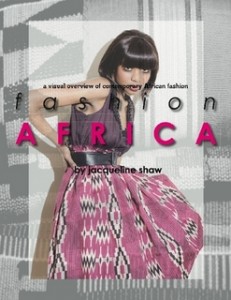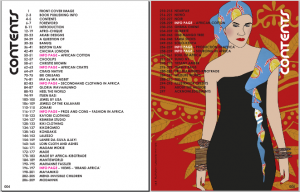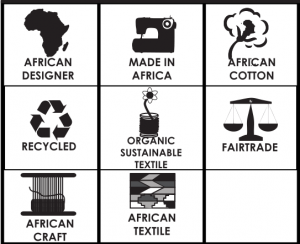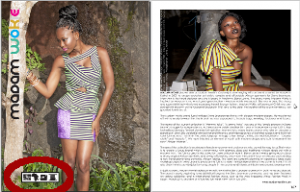 Fashion Africa – A visual overview of contemporary African fashion
Fashion Africa – A visual overview of contemporary African fashion
By: J. Shaw
Publisher: AFG Publishing
Africa isn’t exactly the first geographical location that comes to mind when talking about fashion. At a second thought, and only in the case of those heavily engrossed in the comings and goings of the fashion world, names such as Vivienne Westwood, Bono (from U2, respectively husband of the lady behind the brand Edun), or the former super-model Iman come to mind.
Africa and fashion are two words that on the high-street are only complemented either by a third term (usually ‘ethnic’ or ‘batic’), or alternatively by the slightly surprised look a lady of African descent receives when wearing the easily recognisable prints of the continent. Granted: There exists more than one style of print, but till the day I haven’t learned to distinguish them from one another.
In fact, our Safari clichés are rooted far too well in our subconscious to even imagine that there is such a thing as a fashion scene somewhere on the black continent.
But, of course, there is. Very much so – after all Africa is known for its fascination with all things clothing and trends. For this reason – and the lack of affordable local versions – the used clothing market boomed the way it did, and still does, across the entirety of the continent.

Given such a lack of knowledge altogether, ‘Africa Fashion’ makes a first step towards bringing modern African fashion designers into the consciousness of a wider public.
The book presents in alphabetical order a total of 48 designer brands with short portraits, and brief interviews that explore their commitment to Africa and ethical business practises. The compulsory collection photographs are complemented with drawings by London fashion illustrators, the ensemble of which gives the book a rather fresh and different feel as a whole.
The designers span the whole breadth and width of the spectrum: from brands known at least to some extent in Europe, – example of which would be: Lalesso, Made and Noir – to brands that are very much insider names and only known to the African diaspora or those interested in African fashion: Ituen Basi, NKWO or Oliberté.
Designer portraits aside, the book offers a small selection of ‘extras’ which cannot go unmentioned, namely:


- Eight (8) double sided information pages on: African cotton (2 double spreads), African crafts, secondhand clothing in Africa, pros and cons of producing fashion in Africa, view of the ‘brand Africa’, production in Africa, and sourcing in Africa. The info pages are accessible to a general public, and hence are reaching their target audience suitably.
- An evaluation of each brand – using the icons on the left – with respect to: whether it designed by an African designer, produced in Africa, made with African cotton, made of recycled materials, organic/sustainable textiles, under fair trade conditions, using African craft, or using African textiles. Example: The portrait of Madam Wokie (right, icons circled in red).
What does this book add to what we know already about fashion, ethical fashion in general?
Well, for starters the book does comply with what the title suggests: It indeed is ‘A visual overview of contemporary African fashion‘. It is very possibly – certainly to my limited knowledge – the first book of its kind featuring a range of contemporary African fashion brands. The pictures that accompany the brand portraits are sufficiently representative of their overall work, and in that they are well chosen and meaningful.
The book also makes it clear that qualitative and skill-wise there is no reason why not have fashion either designed or produced in Africa.
However, the book is also a lost opportunity in more than one aspect:
First, a not unsubstantial number of the brands present in the book are African only in the wider sense of the word: some are designed by an African designer, but made in the UK; others are designed by an individual living in Europe or the US, but produced in Africa. Can either of these truly be considered an African fashion brand? After all, such an approach would invariably mean that Marks & Spencer’s isn’t actually a British brand, but rather Chinese, Indian or Sri Lankan …
Second, if we assume as a given the definition as used in this book, then I’m asking myself why there are not – at least by way of example – African brands present that call France, Spain, Italy or Germany their ‘home market’. 2 examples: The widely acclaimed Parisian designer of Comorian descent Sakina M’sa (France / Comore Islands) or Adamah Stein (France / Senegal).
And thirdly and lastly: From my very personal point of view, there are only very few designs that I – with a fairly mainstream fashion sense – would want, or dare, to wear anywhere else then Africa. While there is no doubt that the designers understand their craft, much of what is seen in the book suggests that the collections are targeting primarily the African diaspora in Europe and the US – rather than a more general public.
Granted, I’m possibly not the target audience these brands intend to sell to, yet: Overall I remain undecided whether or not the book does more harm or good to the cause of promoting African fashion brands as contemporary and viable option to an international audience.

